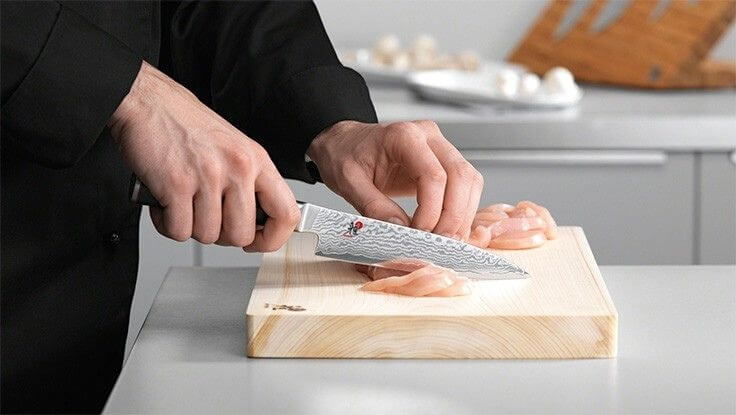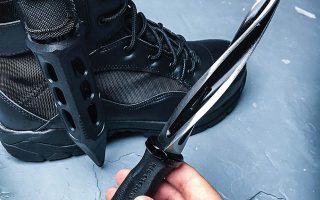How To Close a Pocket Knife
Pocket knives are the most useful tools to carry with you. You need to keep one to make cuts on the go around the house or any trip. Although pocket knives look complex as each one has a different locking mechanism. To keep the blade secured in your pocket space all the knives have a locking system. If you are just getting into knives, learning about how to close different types of knives can be overwhelming.
Before using a knife, the first thing you need to learn is how to safely close and store your knife to avoid any accidental cuts. The general principle of the knife locking mechanism is there will be a piece that blocks the blades’ pivot movement. By releasing the button, the knife blade will fly out of the knife. It might sound unnecessary but you need to master the art of closing a pocket knife safely.
Generally, the lever, frame section or the button of the knife, or other parts of a knife acts as a security clasp for releasing the blade. It varies from knife to knife. In this blog post, we will cover the most popular knife lock system so that you can handle your pocket knife safely with the right opening and closing techniques.
Below I’ll go over and explain precisely, how to close and operate the most popular knife locks. So let’s get right into it!
How to Close a Lockback Knife
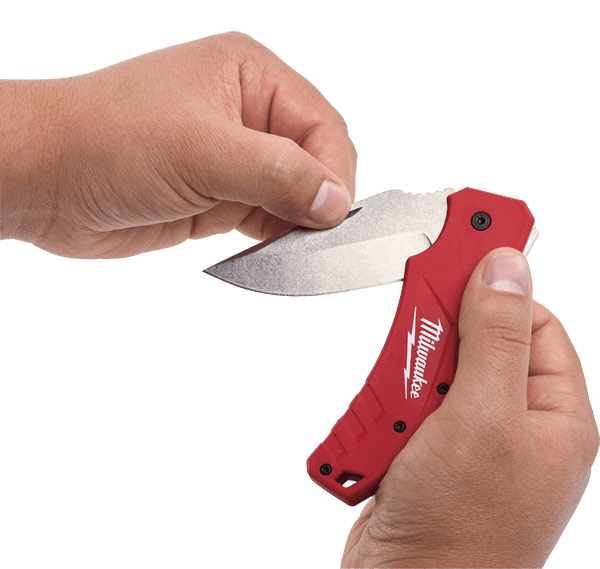
Lockback is a popular widespread locking system. It’s used quite often on a folding knife, hunting knife, decorative knife, and others. It is prevalent than many other locking systems. You may also know this locking system as “back lock” knives. But I prefer to call it “Lockback” as it’s the right one since the lock is on the spine of the knife.
This type of knife design is similar to the axis lock knives. They come with a curved blade and a prominent cleft on the tail of the knife. The blade is designed to easily click into the locking mechanisms with the help of the cleft whenever is pulled out straight.
This is the easiest locking mechanism to lock and unlock as you open the knife the torsion bar on the back of the knife sets it up.
Now, let’s get to the point of what toing and froing you need to take to close a Lockback knife
1. Firstly you have to hold the Lockback knife with your primary hand. Make sure the blade is pointing away from you and is at a nighty degree angle.
2. As soon as you press the lock there you must see a blade fall. And if you keep the exposed portion of the blade at a 90-degree angle the blade will release without hitting your finger.
3. By using the thumb of your dominant hand, press the blade release.
4. While depressing the blade on the spine of the handle, fold the blade towards its closing place with the help of your non-dominant hand. ‘
5. You will hear the “click” when the blade is placed inside the handle chamber. And then you can let go of the lock button.
Again to unlock the blade, simply press on the blade release and it will easily fold the blade back onto the frame.
The lock-back is useful and safe. These locking systems are robust. The blade will hardly get unlocked by accident. Typically used in tactical folding knives this Lockback system is highly reliable and convenient in normal cutting jobs as well as intense tasks that could be deadly if the blade gets exposed unintentionally within your pocket space. It is a great product for most users, after all, knife safety is always on our mind.
How to Close a Slip Joint Knife
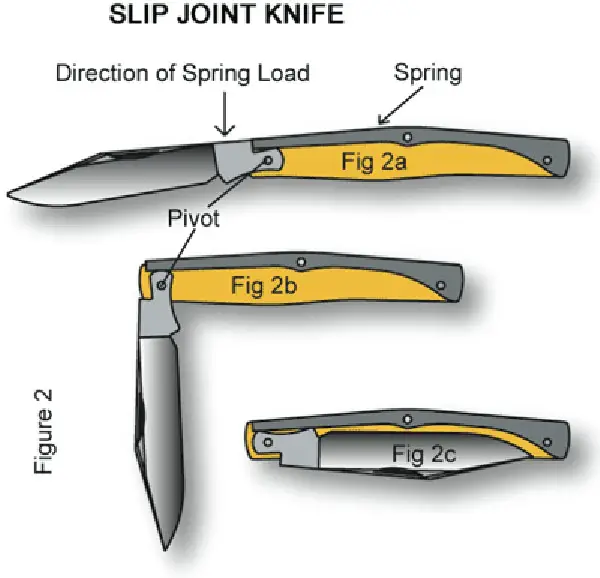
Knives with a slip joint lock are one of the most laid-back types of folding knives. Basically, a slip joint pocketknife has no locking mechanism. It’s merely a detent and you merely push it out of the way to open the knife. It somehow semi-lock the knife. The detent will release when you put downward pressure on the blade.
Let’s take a look at the specific motion and steps of closing the slip joint:
1. Firstly you have to hold the knife handle with your primary hand. Ensure that the blade is facing upward and the pivot screw away from your body.
2. By using the nail nick of your non-dominant hand, carefully grasp the back of the blade.
3. Apply downward pressure to the blade to close it.
4. Fold the blade as far as it can go into the handle cavity.
With a slip joint, you will see, the finger choil is a bit extended. It acts as a finger guard. Cause when the knife is in use the extended choil will make it much harder for the knife to fold into you. But you need to be careful while using a slip joint. Because once there is a small amount of pressure applied to the blade, the joint slips and the knife will come folding down into your finger. And to open the knife you need to apply adequate pressure on the blade.
I do not recommend slip joints for heavy-duty tasks as I find it a bit risky. But it’s great for basic everyday tasks. As it’s very easy to close this type of pocket knife, you become more comfortable opening the slip joint faster, even with one hand.
Overall, slip joint knives are some of the most uncomplicated locking systems to operate. But also it can be quite dangerous. Always watch out for the cutting motion while using the knife. As any downward pressure will release the blade, there is an enormous potential for accidental cuts.
How to Close Frame Lock Knife
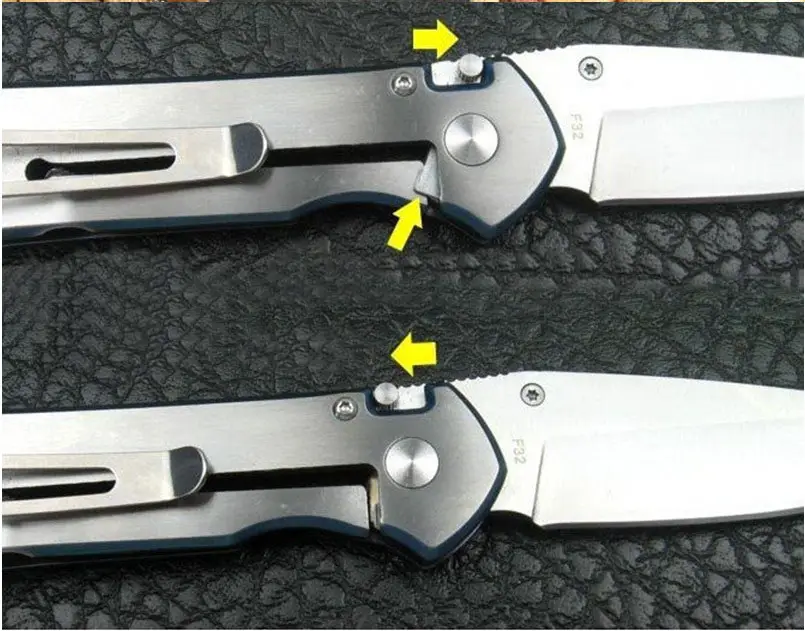
Frame locks are prevalent on many pocket knives. The frame lock is totally similar to a liner lock but without a G 10 handle. And the liner is a little thicker on the frame lock knives. Other than that they operate the same way. The frame lock pocket knife has a moderately lighter and minimal design. As the name would apply in frame lock, the lock is actually the frame of the knife itself not the liner anymore.
With the frame lock, as you open the knife, you would see the frame lock cover the back of the knife and lock into it. The frame of the knife has a disconnected harden steel inside which basically acts as a locking mechanism.
Let’s take a look at the specific steps to close a frame lock pocket knife.
1. Hold the knife handle with your dominant hand. Make certain the blade is facing upward and the pivot screw away from your body.
2. Carefully push or pull the frame lock on the side, depending on the knife. The frame lock is always on the side of the handle.
3. Push the frame out of the way of the blade with your thumb. Begin to close the blade with your index finger.
4. Now get your thumb out of the way and continue closing the blade using your index finger. Fold the blade as far as it can go into the handle cavity.
The frame lock mechanism is very simple yet extremely robust. You can see this mechanism in utility knives and tactical knives. It is super easy to open and close. The outer frame of the knife is basically just an increased part of the part.
Most new frame lock knives have an over-travel stop that prevents the frame to push too far. So while pushing the frame, just be careful not to push it too far. It can break your knife.
How to Close a Liner Lock Knife
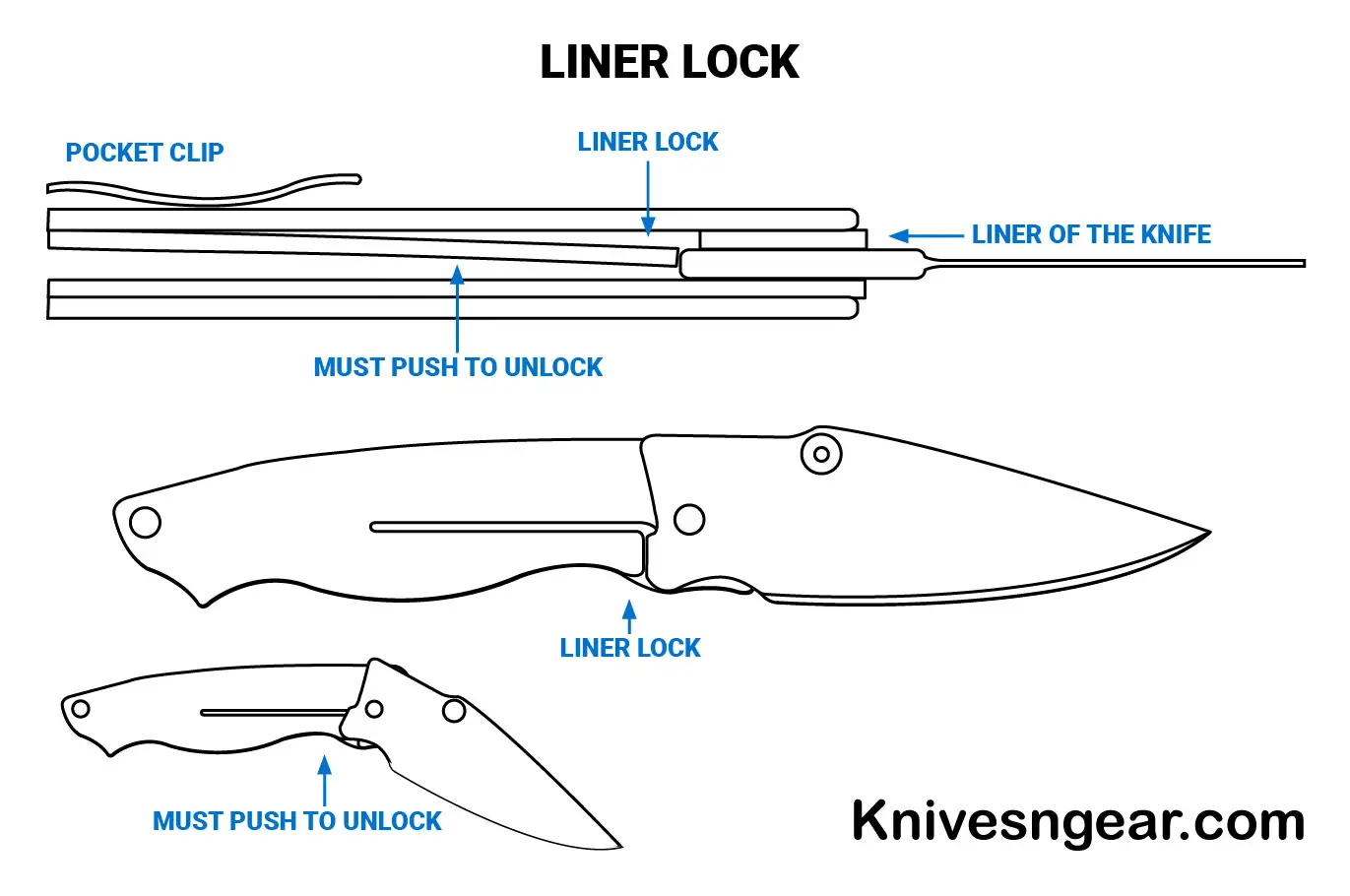
The liner lock is the most common type of locking mechanism in folding knives. Similar to frame lock the construction of this locking mechanism is slightly different by having an inner liner. The outer part is most the G10 handle and inside you will see a metal portion (basically the liner) that holds the knife blade when you open it.
Liner locks are quite robust and provide a very secured locking mechanism. Depending on the knife model, you can find the liner on the back or front of the knife.
The way to close a liner lock is kind of similar to how you would close a frame lock. As mentioned above, for frame lock, you have to push the frame itself aside. And in the case of liner lock rather than pushing the frame on the side, you have to push the metal part which is inside the G10 handle. In some knives, the line is at the bottom of the
On the liner, you will see a lock bar which you can push aside with ur finger. That will free the pivot screw movement and release the blade.
Now let’s take a look at the specific steps to close a liner lock pocket knife.
1. Hold the open knife handle in your primary hand. Ensure that the blade is facing upward and the pivot screw away from your fingers.
2. Now reach across the liner lock arm and just displace it by pushing it to the side of the handle. the liner has to be in a parallel position with the handle.
3. Now as the pivot screw is free slowly begin to close the blade with your index finger.
4. Once you have folded the blade about 1/4 of the way, make sure you move your exposed thumb out of the way. And fold the rest of the blade until you hear it click into the knife chamber.
I have seen liner lock leads to the most cuts for knife newbies. So take it slow and it will become easier for you to handle.
A liner lock is very much identical to a frame lock. You might confuse the liner and the frame. So look for the side of the handle that has a bit of an opening. That is the side to push through. It’s always almost on the left side. Right-hand users can easily get a hold of it.
Only a few leftie knives have the lock arm on the opposite side. This, however, doesn’t affect their functionality as the locking mechanism has nothing to do with the knife’s reliability.
How to Close a Button Lock Knife
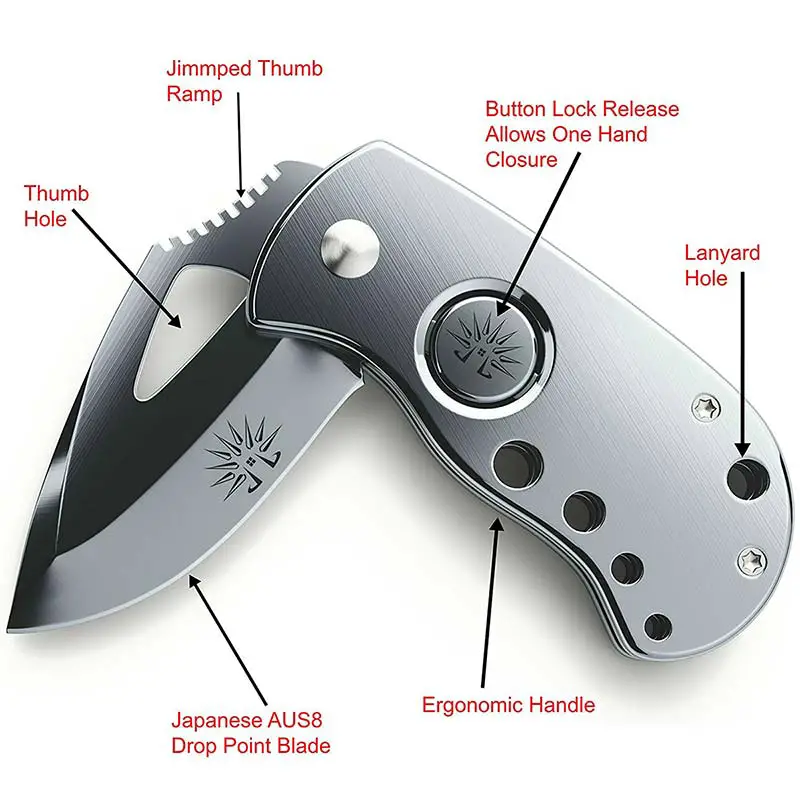
The button lock is said to be a novelty locking system as many people find them super desirable and flashy. You can find this type of blade lock mechanism on stiletto knives, rescue knives, or spring-loaded folders.
Let’s take a quick look at the specific steps you need to take to close a button lock knife safely and quickly.
1. Firstly you have to hold the button lock knife with your primary hand. Keep the push button on the handle facing upward. Keep the blade facing away from your body.
2. Use your thumb to push the button lock on the handle and hold it down cause that allows the blade to move freely.
3. Now with your pointer finger initiate the blade movement to downward motion.
4. Once you have closed the blade about 1/4 of the way while holding that with your pointer finger you are going to move your thumb over and grab the side of the blade and bring it the rest of the way until it clicks into place.
Button locks are my favorite because of their quick and easy opening and closing mechanism with just a push to the button. So what is basically being done here is there’s a coil spring inside the pivot screw and so spring tension is built up when you close the blade all the way it locks in. And when you push the button, you are allowing that built-up pressure to release and make the blade fly open.
This locking mechanism is super easy but at the same time equally risky. As you could release the blade with a single push of the button, there are chances of the unwanted opening of the knife into your pocket space and make some serious damage.
This easy release makes button lock knives illegal or restricted in many states. Make sure to be extra careful while handling an automatic push-button knife.
How to Close a Bar Lock Knife / Axis Lock
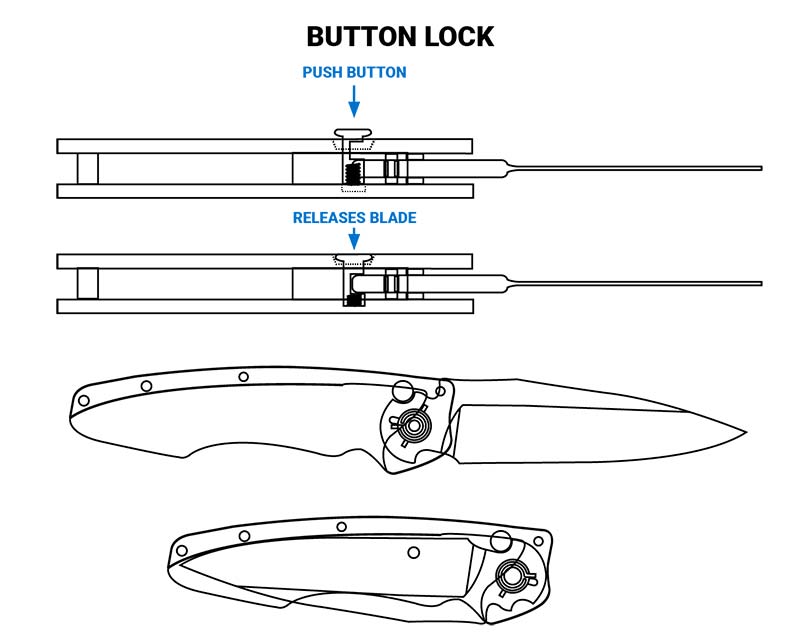
Bar lock knives are a common locking mechanism on your pocket knife which usually offers a more convenient experience when using. This is one of the safest locks to close. None of your fingers need to go in the path of the cutting edge while closing the knife. On the side up and away from the pivot there you will see posts sticking through. You have to pull them back so that the blade can move freely.
Below I’ll take a look at the specific steps you’ll need to go through to close an axis lock knife safely.
1. Firstly you have to hold the axis lock knife with your primary hand.
2. Look for the locking bar or the posts, they are usually located on both sides of the handle near the blade’s base. Pull them back using both of your thumb and pointer finger.
3. Use your other hand to push the spine of the blade towards its closing position. Also make certain your fingers are clear in the paths.
4. Once the blade is closed about 1/4th of the way, stop pulling the locking bar. And close it fully.
The bar lock is a very classic knife lock mechanism. While the bar lock is the general name for this type of knife lock since always, Benchmade has decided to call their version “Benchmade Axis Lock”.
There’s a small bar situated inside a slot in the knife’s handle. It fits perfectly inside a notch in the rear of the blade. And the bar is spring-loaded.
When the bar is pulled backward, the blade gets related by wing freely. Once you let go of the bar, the built-up spring tension releases the blade. This is how the axis lock work.
Overall, the bar lock, or Benchmade Axis Lock is a very durable and secured locking system. It becomes your second nature closing and opening it fast in no time.
How to Close a Compression Lock Knife
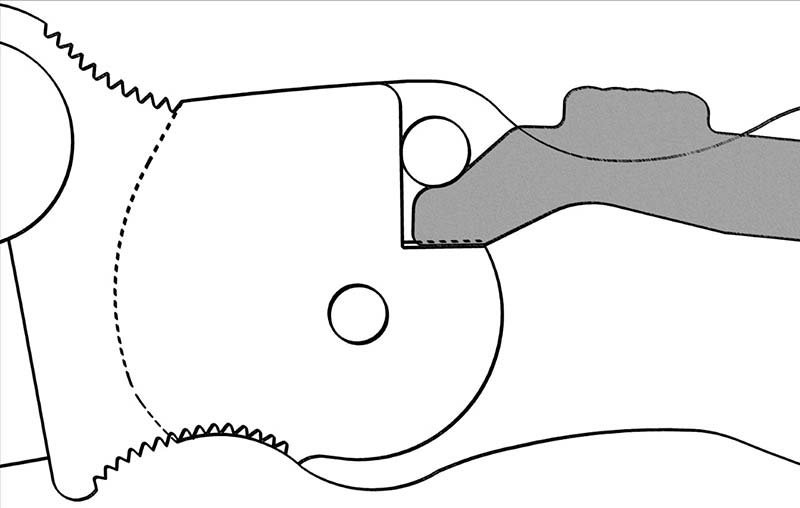
Compression lock knives are SUPER similar to liner locks. But there are some differences. When you open the knife, you can see the liner on the top scales that pops over. So it looks like a liner lock, but unlike the traditional liner lock where we have to push the liner from inside, there’s a cut-out on the back scale that gives you access to the liner.
Let’s look at how compression lock knives work and how to close them properly and safely.
1. Hold the knife handle with your main hand. This locking mechanism makes a sudden blae release. So make certain that the blade is in a ninety-degree position.
2. With your dominant thumb push over the locking mechanism to the back of the handle. That will release the blade making it move freely.
3. Using your other hand, close the blade slowly.
The way that you close a compression lock knife is almost the same as how you would close a liner or frame locking knife. You can close this locking design by using gravity too. Hold the knife at a 45-degree angle while you depress the lock, you will see the blade just freely drops and closes.
Without getting TOO technical, a compression lock uses a liner inside the handle to hold the blade. It’s the piece of metal you push to the side to close or open the knife. The liner sits perfectly into the blade’s base.
Close knife in style with one hand
This is for all my knife crazies. We have gotta open the knife with a little bit of sass right? Those of you who have been handling folding knives for some time now can try opening and closing them using only one hand. This technique will allow you to enjoy yourself more while using your knives.
However, you can only try this method only when you’ve got quite a familiar handling pocketknife. Don’t try closing your knife with one hand if you’re not familiar with knives that much. Otherwise, you can hurt yourself while trying these methods. So take it slow and soon it will become second nature to you. Remember, the following steps will take a lot of practice. And reputation helps my friend when you are learning something new.
Here is how to close a pocket knife with one hand using two of the mentioned methods:
1. The standard way – Go ahead and take all your fingers out of the way of the back of the knife. You have to hold it by pivot point only by using your thumb, pointer, and middle fingers. Keep your thumb on one side and the middle fingers on the opposite side of the pivot point. Keep your index finger free. Push your pointer finger on the spine of the blade and it will easily drop and get back into the handle chamber.
2. The stylish way – For this method, you should start with a similar hold on to the knife. Take all your fingers out of the closing way. You have to hold it by the back and sides only. The only difference is that you don’t need to free your pointer finger. Have the best grip on the knife handle with all of your fingers. Position the knife facing the ceiling and the blade must be straight. Now is the tricky part, so pay attention to it while you do that. Flick the blade and at the same time perform a flip with your wrist too. Do it swiftly and force the blade to its closing position. Remember, you won’t be able to master this trick just like that. So don’t be frustrated if you fail at the first attempt.

Hi, my name is Taras Kulakov and I’m a knife enthusiast. I have been collecting knives for over 30 years and I’ve owned literally thousands of different models over that time. My goal with this site is to share some of what I’ve learned about knives. You can find more info about Taras Kulakov here.

